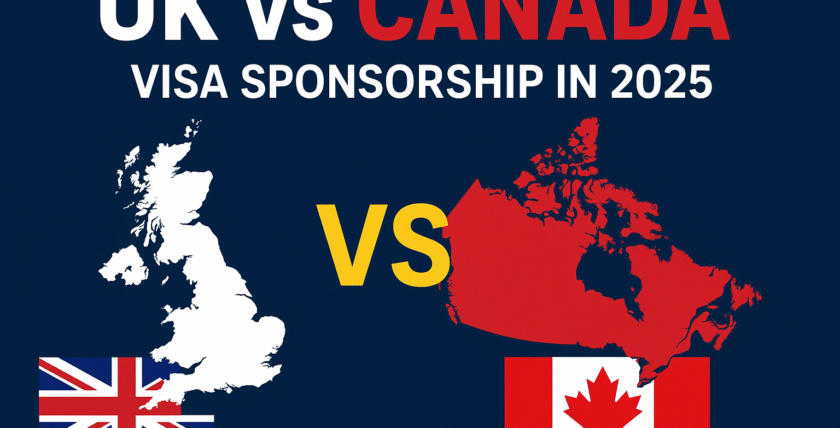Canada visa sponsorship jobs – Seeking a genuine way to move to Canada with a job offer? This guide explains what employer sponsorship means, how to find companies that sponsor, the application process, the documents you’ll need, and common mistakes to avoid in plain English.
What “Employer Sponsorship” Really Means
In Canada, “employer sponsorship” usually means you’ll apply for an employer-specific (closed) work permit that ties you to one company and role. You qualify in one of two ways:
-
LMIA-required (TFWP): Your employer first gets a Labour Market Impact Assessment (LMIA) approval from Service Canada. With the LMIA letter and job offer, you apply for a work permit. IRCC Canada
-
LMIA-exempt (IMP): In some categories (e.g., intra-company transferees, certain free-trade agreements, significant benefit), the employer doesn’t need an LMIA. Instead, they submit an Offer of Employment through the Employer Portal and pay the $230 employer compliance fee. You use the Offer of Employment number to apply.
Either way, IRCC’s employer-specific work permit page confirms you’ll submit your employment contract plus LMIA copy or offer of employment number. Government of Canada
How to Find Companies That Sponsor (Practical Tactics)
-
Job Bank (Government site):
Search Canadian jobs and look for postings showing LMIA pending/approved indicators for temporary foreign workers. Also note: employers cannot make you pay for an LMIA that’s illegal. Job Bank -
Shortage & fast-track streams:
-
Global Talent Stream (GTS): Tech and specialised roles can get 2-week processing when both LMIA (GTS) and work-permit applications meet criteria.
-
Recognised Employer Pilot (REP): Select employers with a strong LMIA history may benefit from streamlined hiring in listed occupations. Government of Canada
-
-
Target LMIA-exempt routes (IMP):
If you qualify (e.g., intra-company transfer, international agreements), ask the employer to submit the Offer of Employment in the Employer Portal and give you the offer number. -
Company career pages & LinkedIn:
Search with terms like “visa sponsorship,” “LMIA,” “IMP,” “Global Talent Stream,” and filter by location in Canada.
Step-by-Step Application Process (Two Paths)
A) LMIA-Required (Temporary Foreign Worker Program)
-
Employer recruitment & LMIA:
Employer advertises the role and applies to Service Canada for an LMIA (different rules for wage level/industry; note special rules for primary agriculture). -
Receive job offer + LMIA:
If approved, the employer sends you the LMIA letter and detailed job offer/contract. Canadavisa.com -
Apply for your work permit (outside/inside Canada):
Submit your application with job offer, contract, LMIA & LMIA number through IRCC. IRCC Canada -
Biometrics, medicals, police certificate (if required):
IRCC may request these. -
Decision & entry to Canada:
If approved, you receive a port-of-entry letter; the actual work permit is issued when you arrive.
B) LMIA-Exempt (International Mobility Program)
-
Employer submits Offer of Employment:
Employer uses the Employer Portal, pays the $230 compliance fee (unless exempt), and gives you the offer of employment number. -
Apply for your work permit:
Include employment contract and offer number; complete biometrics/medicals if asked. -
(If eligible) Fast-track via Global Skills Strategy:
Some high-skilled roles qualify for 2-week processing when the criteria are met and family members apply together.
Required Documents (Typical)
-
Valid passport and digital photo
-
Employment contract
-
LMIA letter & number (TFWP) or Offer of Employment number (IMP)
-
Proof of qualifications & work experience (CV, reference letters, licenses)
-
Police certificate (as requested by IRCC; must be recent)
-
Medical exam (if your job/length of stay requires it)
-
Biometrics (fingerprints and photo)
-
Translations of any non-English/French documents by a certified translator.
IRCC’s official work-permit guide details how to apply from outside Canada and what you may be asked to provide. Government of Canada
Common Mistakes to Avoid
-
Paying for the LMIA or job offer: It’s the employer’s responsibility; you must not be charged for the LMIA. Job Bank
-
Wrong pathway: Applying under LMIA-exempt when the role actually needs an LMIA (or vice-versa). Double-check the category with the employer. Government of Canada
-
Missing employer steps: Employer forgetting the Employer Portal submission and $230 compliance fee for IMP cases.
-
Incomplete documents: Skipping biometrics, police certificates, or medicals when requested can delay or refuse your file.
-
Fake or altered documents: Lead to refusal and potential bans. Always use genuine records.
-
Relying on unofficial “agents”: Apply via official IRCC portals and employer links; avoid anyone promising guaranteed approvals.
Quick FAQ
How fast is processing?
Eligible high-skilled roles may qualify for 2-week processing under the Global Skills Strategy if conditions are met. Others vary by stream and visa office.
Do all jobs need an LMIA?
No. Many IMP categories are LMIA-exempt, but employers must still submit an Offer of Employment and often pay the compliance fee.
CTA Get Your Offer Verified
Avoid scams and wasted applications. JapaGuru helps you:
-
verify Canadian job offers and employer eligibility,
-
Choose the correct LMIA vs IMP pathway, and
-
Prepare a complete work permit file.
Book a consultation now to get personalised guidance and a document checklist tailored to your role and province.
Also See:
- UK vs Canada: Which is Better for Visa Sponsorship?
- Canada Visa Sponsorship Programs for International Workers
- How to Find Genuine Visa Sponsorship Jobs (Without Getting Scammed)


